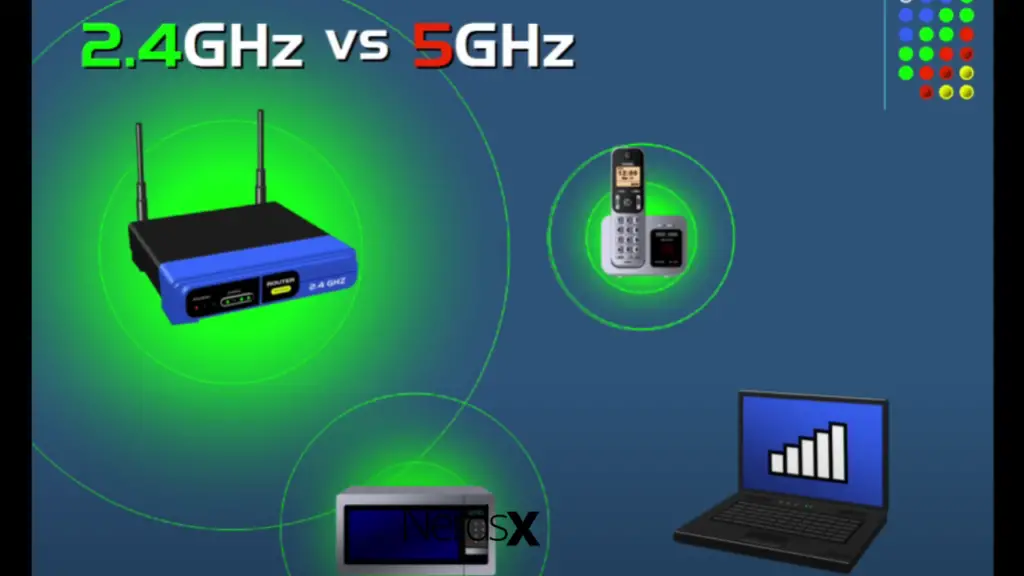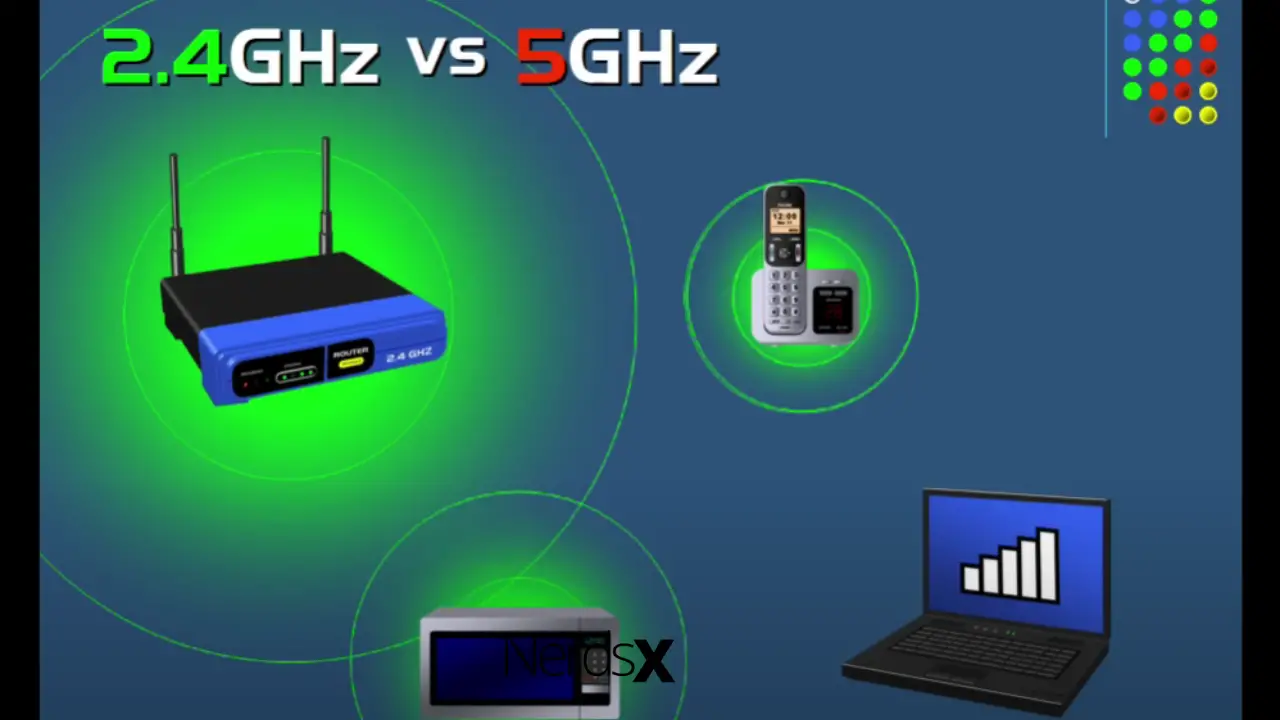Most Wi-Fi routers are dual-band, which means they can send a signal on both the 2.4 and 5 GHz frequencies. But what exactly does this imply? Is it possible that they’re both connected to the same Wi-Fi network? Why do you require two separate Wi-Fi signals? Is one superior to the other?�?
Stay with us on this informative page to familiarize yourself with the workings of 2.4GHz and 5GHz.
What Are The Differences Between The Dual-Band Router And The Single-Band Router?
A dual-band router can send and receive radio waves in two frequency bands: 2.4 GHz and 5 GHz. You get two Wi-Fi networks with dual-band routers since they transmit two frequency bands.
Until recently, most routers used the 802.11b protocol, confined to the 2.4 GHz range. The newer 802.11ac standard, which covers both the 2.4 GHz and 5 GHz bands, is now used by most current routers.
Dual-band routers are also available in two varieties: selectable and simultaneous.
At any one moment, a selected dual-band router can only support one Wi-Fi network, either the 2.4 GHz or the 5 GHz network.
Although it is essentially a single-band router, you have the option of selecting whatever frequency you wish to utilize. All devices in your house must share a single Wi-Fi network with this router.
A simultaneous dual-band router supports two different 2.4 GHz and 5 GHz Wi-Fi networks simultaneously, giving you the option of choosing between the two networks anytime you use your device.�?
You’ll also get double the bandwidth (or speed) and the prospect of having separate networks for various devices. For example, you may use the 5 GHz network for video streaming while keeping your smart home devices on the 2.4 GHz network.
What Is A Gigahertz (GHz)?
The unit of measurement for gigahertz is GHz.
The technical name for cycles per second or frequency is Hertz (Hz). The Hz unit measures wave frequencies, including radio, sound, and electric currents.
A hertz refers to one cycle per second, a megahertz (MHz) is one million hertz per second, and a gigahertz is 1,000 megahertz per second (1,000,000,000 Hz).
In practice, this implies that a gigahertz transmits approximately one billion cycles per second. The greater the frequency, the more cycles per second there are.

Wi-Fi And GHz
A radio wave is what Wi-Fi is. The frequency between the devices that send and receive Wi-Fi signal waves gets referred to as GHz. The 2.4 and 5 GHz band frequencies are now available for Wi-Fi.
2.4 and 5 GHz are the allocated routes for these automobiles to go between various sites if you think of radio bands as a highway system and signal waves as autos (Wi-Fi devices).
The wireless frequency describes the vehicle’s speed and distance traveled on the roadway. A higher frequency (5 GHz) has a faster speed but covers less distance, similar to how a car consumes gasoline. A lower frequency (2.4 GHz) reaches further but is slower.
Both bands have Wi-Fi channels or roadway lanes dedicated to them. The width and overlap of a channel, like the width and overlap of a lane, can alter traffic flow in a band.
Bandwidth refers to the quantity of data a system can send in a given length of time. The data transport rate, measured in bits per second, is bandwidth (Mbps). Higher bandwidth can transport more data. The greater the frequency, the higher the possible bandwidth.
The bandwidth performance is also affected by the frequency channel. Channel overlap and merging lanes can cause traffic to collide (interference). A narrow lane can slow traffic. Higher bandwidth performance gets achieved by using wider lanes with fewer overlaps.
What Is 2.4 GHz Wi-Fi, And How Does It Work?
For Wi-Fi, the usual public highway is 2.4 GHz. It is a radio transmission that operates in the ultra-high-frequency spectrum (UHF).
UHF is a mid-range frequency that balances longer wavelengths subject to higher air interference and shorter wavelengths readily occluded.
UHF can travel for miles over the visible horizon unless topography or buildings impede it. It is capable of penetrating most ordinary walls. As a result, 2.4 GHz is a viable option for many professional and consumer devices.
Since the initial Wi-Fi standard release in 1997, practically all wireless devices have been compatible with 2.4 GHz by default. This Wi-Fi frequency is used by cell phones, routers, baby monitors, smart TVs, and Bluetooth devices.
There are eleven channels in the 2.4 GHz radio frequency, with just three of them not overlapping. With a width of roughly 5 MHz, these channels are likewise relatively small, making the frequency more sensitive to interference.
The 2.4 GHz band, like other heavily-used public access roads, may become clogged with traffic, especially during peak usage (rush hour).
Because of its more comprehensive range and higher signal penetration, 2.4 GHz is ideal for in-home networks because it can successfully connect to devices in adjacent rooms. It also has a vast footprint.
However, slower speeds, interference, and congestion plague this Wi-Fi frequency; a 2.4 GHz network may not meet high-bandwidth requirements.
What Is 5 GHz Wi-Fi, And How Does It Work?
When the current Wi-Fi frequency is 5 GHz, it allows data to go quicker while experiencing less congestion, but only over a shorter distance. It is a type of radio transmission that operates at a super-high frequency (SHF).
SHF is a frequency band that is higher than UHF. Because the SHF wavelength is so short, it is classified as a micro-wave (a tiny wave, not a cooking device).
SHF is very line-of-sight reliant, and it seldom penetrates barriers as well as UHF. Because 5 GHz waves are smaller, quicker, and less crowded, they’re ideal for a variety of specialized devices, such as medical equipment.
In 2009, 5 GHz got included in the Wi-Fi standard. Although it is newer than 2.4 GHz in device compatibility, it is still widely accessible for most Wi-Fi alternatives.
Over 100 channels in the 5 GHz range have 24 overlappings. Many of these channels have bandwidths ranging from 20 to 80 MHz. As a result of these possibilities, there is reduced congestion and interference and better bandwidth performance.
Data rates of up to 1300 Mbps may be sent at 5 GHz. Its speed is ideal for in-home networks that require a lot of bandwidth. 5 GHz may also be the superior Wi-Fi option if you rely on a reliable connection, such as video conferencing.
However, if you need to cover a vast area or pass through numerous barriers, a 5 GHz network may be challenging to set up.
Why Is My 5GHz�?Slower Than My 2.4GHz?
The lower the frequency, the greater the wireless signal range; as a result, devices on a 5 GHz network will have a lower range than those on a 2.4 GHz network.
A 5GHz wireless LAN will almost always be slower than a 2.4GHz wireless LAN because the 5GHz frequencies are more susceptible to attenuation, resulting in a weaker signal at the same distance. A weaker signal results in a lower SNR (signal-to-noise ratio) and a worse quality connection when the noise levels are on the same level.
Long after the approval of 802.11a (5GHz, 54 Mbps) and 802.11b (2.4GHz, 54 Mbps), wireless networks became ubiquitous with the ratification of 802.11g (2.4GHz, 54 Mbps) (2.4GHz, 11mbps).
The GHz band does not always determine the maximum Wi-Fi speed that a wireless device employs. For example, depending on the device, the 2.4GHz band may handle up to 450Mbps or 600Mbps; but, because so many devices utilize the 2.4GHz band, congestion might result in dropped connections and reduced speeds.
The 5GHz frequency, on the other hand, can handle up to 1300 Mbps. Because fewer devices utilize it and have more channels for devices to use than the 2.4GHz band, it tends to be less congested. The maximum speed depends on whether the access point supports 802.11b, 802.11g, 802.11n, or 802.11ac wireless standards.
Any Longer ranges and transmission through walls and solid objects are better suited to the 2.4GHz band’s waves. As a result, 2.4GHz is preferable if you require a more comprehensive range of coverage for your devices or if you have a lot of walls or other obstacles to cover.
Tellingly, the 5GHz band has shorter waves that make it less capable of passing through walls and solid objects. That is due to the particular features of electromagnetic waves: at higher frequencies (5GHz), waves attenuate more. As a result, different impediments such as walls, floors, ceilings, doors, and others can easily affect the signal.
Conclusion
You may distribute your devices across two Wi-Fi bands if you have two of them. That reduces network congestion and improves network speed across all of your devices. Some modern routers even let you use the identical Wi-Fi SSID for both 2.4 and 5 GHz channels, switching between them automatically to provide the optimal speed and coverage. Because everyone’s needs are different, we recommend trying out various Wi-Fi bands and devices to see what works best for you.

